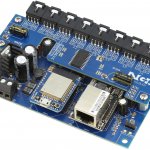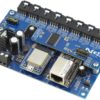
introduction
The Ultimate Serial to I2C Converter Adapter
Introducing the world’s most powerful and expandable Serial to I2C Converter. With Sixteen nodeLynk I2C Expansion Ports and Two Interchangeable Communications Ports compatible with Digi XBee®, this powerful I2C adapter offers the highest possible conversion speed with the most efficient command set available. Communications modules may be interchanged for your choice of communication requirements. Based on the endNode architecture, this controller provides an excellent platform to help simplify communications to otherwise complex I2C devices. Over a year in development, this device served as the development platform for our endNodes architecture, which includes an incredible command set for relay control, far beyond I2C conversion. New features include hardware I2C communications now supporting speeds up to 700KHz. Set the communications speed of each nodeLynk I2C Port as part of Device Configuration. This device now includes a new command set that simplifies read and write operations to I2C devices. New I2C Bus Scan functions scans and reports all detected devices on each I2C port in less than 1 Second.An I2C Converter with Brains: endNode Architecture & ProXR Enterprise
We’ve also added ProXR Enterprise to the command set, which is our most powerful relay control command set to date. Capable of controlling up to 1,024 relays using 16 nodeLynk I2C ports, this is our most expandable relay controller we have ever manufactured. Designed to work with all MCP23008 and MCP23017 I2C Relay Controllers, ProXR Enterprise adds powerful commands for turning relays on or off, toggling the state of relays, pulsing relays, and controlling relays in groups. ProXR Enterprise also offers powerful relay timer capabilities to activate relays for a duration of time or to trigger different commands when timers finish their counting cycle. Integrated Macros make it possible to send a simple command to execute a list of up to eight commands in the background. Powerful startup functions allow you to execute commands when power is first applied to the controller in addition to complete power-up relay state control. Integrated Non-Volatile FRAM memory allows unlimited read/write capabilities without memory degradation and no battery backup required. FRAM memory keeps track of relay status, timers, macros, and many important system settings. New Relay Counters control relays in patterns using Counter Increase and Decrease functions. Relay Counters can be used for efficient lighting control, emergency lighting, or signage applications. Automatic and Manual Relay Refresh Modes allow you to send relay control commands without affecting relays. When you ready, simply send a refresh command and refresh every relay connected to the controller.The Best I2C Converter with Sixteen Hardware nodeLynk I2C Ports
With 16 on-board nodeLynk I2C Ports and up to 2 Amps Shared Among All Ports, the converter offers a powerhouse of expansion options. Connect Relays, GPIO, Gas Sensors, Temperature Humidity Sensors, Thermocouples, and 4-20mA current loop input output controllers. Expand anytime to include voltage detection, current monitoring, programmable FET control, pulse width modulation, and much more. The dual port adapter offers more expansion and compatibility than previous generation controllers. As a serial to I2C adapter, this device is future proof and ready to talk to the next generation of sensors and controllers without the need for firmware updates. Simply update your software to talk to the latest generation of I2C devices.I2C Converter with Two Digi XBee® Compatible Communications Ports for Wireless Communications
New Wireless Protocols for Long Range Wireless Communications up to 2 Miles are now supported in native API communications structure. Send commands to this nodeLynk I2C converter from a wireless modem and command responses will be sent back to the modem. This nodeLynk I2C converter supports the use of multiple wireless modems, as all responses are coded to return to the origin. Supports Select Digi 900MHz, 868MHz, and 2.4GHz Communications Options for worldwide compatibility with the best possible range legally allowed.USB to I2C Conversion
Convert USB to I2C by loading a USB interface into a communications socket. The USB communications module will mount as a Virtual COM Port on your PC for communications using simple serial commands at 115.2K Baud.RS-232 to I2C Conversion
Convert RS-232 to I2C by loading a RS-232 interface into a communications socket. This nodeLynk I2C converter will convert RS-232 to I2C, allowing the use of simple serial commands at 115.2K Baud. Connect to desktop computers or embedded systems to greatly simplify communications to I2C devices.RS-485 to I2C Conversion
Convert RS-485 to I2C by loading a RS-485 interface into a communications socket. This nodeLynk I2C converter will convert RS-485 to I2C, allowing the use of simple serial communications to talk to a multi-drop RS-485 network of I2C Converters.Bluetooth to I2C Conversion
Bluetooth to I2C Conversion requires the use of the WiFi option during checkout, users may choose to use the WiFi, Bluetooth, or USB communications technologies by using a single WiFi module that integrates all three technologies into a single communications module.Ethernet and WiFi to I2C Conversion
Network communications could not be any easier. Simply associate this device with your network using WiFi (2.4GHz Only) or a Ethernet cable connected directly to your router, open TCP socket 2101 and start sending and receiving TCP data. Both Ethernet and WiFi options support DHCP, Programmable TCP Port, and a Programmable Static IP address. Both communication options also support web page configuration of communication technologies. The WiFi Option Supports WiFi TCP/IP and WiFi MQTT Communications.MQTT Over WiFi
Our nodeLynk I2C Converter becomes a internet controlled device when using the WiFi option. Paired with our new WiFi communications module, the MQTT communications option may be used, allowing this device to talk directly to MQTT servers using a single publish and subscribe topic used for transporting low-level I2C messages. This effectively allows any command to be executed via MQTT communications for remote operation from anywhere in the world.I2C Converter Re-Engineered
This device acts has a hardware dual port serial to master hardware I2C protocol converter designed to communication with NCD nodeLynk I2C node devices. I2C Master controllers initiate communications to node devices such as ADC, DACs, Potentiometers, PWM controllers, GPIO controllers, and a wide variety of sensors. I2C node devices are always speak when spoken to, they do NOT initiate communications with a master I2C controller. Conversion works by sending a single hardware I2C port selection along with a I2C start address as well as any associated parameters, as well the number of bytes you would like to request from the I2C device. The I2C converter will exchange all data and report the response from the I2C device via a serial format. The term “hardware” is used to indicate that dedicated hardware is used for all serial and I2C communications. This device does NOT use a virtual serial ports or I2C ports which would greatly limit communications speed. Instead, this device uses dedicated hardware peripherals for all communications to greatly enhance speed and reliability of communications. The term “master” is used to indicate this device will initiate communications with a node. It is not possible for a node to initiate communications with a master, as this is not supported in the I2C protocol.This device now includes more powerful commands that execute faster than previous generation controllers including I2C Bus Scan, used to displays all devices connected to a nodeLynk I2C port. New I2C converter commands for I2C Write, I2C Read, and I2C Write/Read operations, which are now executed using hardware I2C ports rather than software emulated ports found in previous generation controllers. The new hardware I2C ports offer I2C Bus Speeds up to 700KHz per nodeLynk I2C Port. I2C Port Switching and Communications is now executed as a single command, offering incredible speed for switching ports and executing read/write operations with a single transaction.New I2C Software for Windows
- Designed to work with AnyI2C for learning I2C Communications. Of course we had to support AnyI2C, but we’ve made some updates to improve speed and compatibility with this device.
- Designed to work with Alpha Station for Advanced Features. Use Alpha Station to explore our new ProXR Enterprise command set or develop your own Visual Studio code using our libraries.
- Be sure to check out the Resources section of our web site, endNode devices are heavily documented with tons of helpful information.
features
how to use
documents



COMMENTS